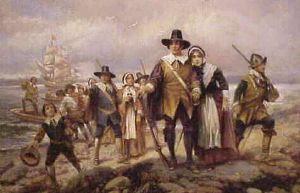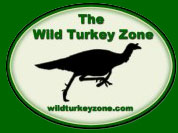The
History of Thanksgiving
by Rob Ramsdale 11/9/04
|
History
of the First Thanksgiving
|
|
|
|
The
First Thanksgiving -- Pilgrims
 The
Pilgrims were English Separatists who founded (1620)
Plymouth Colony in New England. In the first years
of the 17th century, small numbers of English Puritans
broke away from the Church of England because they
felt that it had not completed the work of the Reformation.
They committed themselves to a life based on the
Bible. Most of these Separatists were farmers, poorly
educated and without social or political standing.
One of the Separatist congregations was led by William
Brewster and the Rev. Richard Clifton in the village
of Scrooby in Nottinghamshire. The Scrooby group
emigrated to Amsterdam in 1608 to escape harassment
and religious persecution. The next year they moved
to Leiden, where, enjoying full religious freedom,
they remained for almost 12 years.
The
Pilgrims were English Separatists who founded (1620)
Plymouth Colony in New England. In the first years
of the 17th century, small numbers of English Puritans
broke away from the Church of England because they
felt that it had not completed the work of the Reformation.
They committed themselves to a life based on the
Bible. Most of these Separatists were farmers, poorly
educated and without social or political standing.
One of the Separatist congregations was led by William
Brewster and the Rev. Richard Clifton in the village
of Scrooby in Nottinghamshire. The Scrooby group
emigrated to Amsterdam in 1608 to escape harassment
and religious persecution. The next year they moved
to Leiden, where, enjoying full religious freedom,
they remained for almost 12 years.
In 1617, discouraged by economic difficulties,
the pervasive Dutch influence on their children,
and their inability to secure civil autonomy, the
congregation voted to emigrate to America. Through
the Brewster family's friendship with Sir Edwin
Sandys, treasurer of the London Company, the congregation
secured two patents authorizing them to settle in
the northern part of the company's jurisdiction.
Unable to finance the costs of the emigration with
their own meager resources, they negotiated a financial
agreement with Thomas Weston, a prominent London
iron merchant. Fewer than half of the group's members
elected to leave Leiden.
A small ship, the Speedwell, carried
them to Southampton, England, where they were to
join another group of Separatists and pick up a
second ship. After some delays and disputes, the
voyagers regrouped at Plymouth aboard the 180-ton
Mayflower. It began its historic voyage on Sept.
16, 1620, with about 102 passengers--fewer than
half of them from Leiden. After a 65-day journey,
the Pilgrims sighted Cape Cod on November 19. Unable
to reach the land they had contracted for, they
anchored (November 21) at the site of Provincetown.
Because they had no legal right to settle in the
region, they drew up the Mayflower Compact, creating
their own government.
The settlers soon discovered Plymouth
Harbor, on the western side of Cape Cod Bay and
made their historic landing on December 21; the
main body of settlers followed on December 26. The
term Pilgrim was first used by William Bradford
to describe the Leiden Separatists who were leaving
Holland. The Mayflower's passengers were first described
as the Pilgrim Fathers in 1799.
Wampanoag - Native American Tribe
Long before the Pilgrims landed in
New England and settled in Plymouth, the area was
home to the Wampanoag, called "People of the
dawn" because they lived in the east. The Wampanoag
lived by farming, fishing, hunting and gathering.
In the spring, whole villages, moved
to the seashore to fish and plant crops - corn,
squash and beans. Since their homes were often made
of woven mats streched with wood frames, they could
carry the mats with them and leave the wooden structures
behind for their return. In the fall and winter
they moved inland to the forests of oak, maple and
pine where they hunted deer, wolf, bear, beaver,
moose, wild turkey, raccon, otter, and wildcat.
From the streams, rivers , lakes and ocean they
took fresh and salt water fish; in winter they fished
through the holes of the ice.
The Wampanoag were used to giving
thanks for nature's bounty. They thanked the spirits
of the game they killed for food and thanked the
Creator, Kiehtan, for good harvests. They believed
that corn - their most valued food - was a gift
from Kiehtan.
The presence of the Wamanpoag sachem,
Massasoit, and his men at the Harvest Home was fitting.
The Pilgrims had many reasons to thank them. Massasoithad
made a traty with the Pilgrims which had kept their
fields and homes safe. Squanto had shown the Pilgrims
how to plant corn, the most plentiful crop they
harvested in th e fall of 1621.
Plymouth Colony
The Pilgrims worked hard to survive
in the new land. Coming ashore in late December
made their task that much harder battling the cold
weather and snow. They constructed homes of forest
logs and sticks woven together. They mixed sand,
clay, water, and straw to make a daub plaster to
cover the walls. Pilgrim children were very busy
with daily chores including: tending the fires,
preparing meals, setting the table, milking goats,
fetching water, and many others. They had very little
time for play.
The Pilgrims hit hard times when they
settled in the New Land. They had brought wheat
to plant but it would not grow in the rocky soil.
They were suffering a food shortage, living in dirt
shelters, and many were dying. Due to their fear
of the Native Americans, the Pilgrims would bury
the dead at night so the Native Americans could
not see how many were dying. Only half of those
that traveled to the new land survived the harsh
winter. The Pilgrims were in desperate need of help.
Imagine the Pilgrims surprise when
a Native American named Samoset strolled into the
village and spoke to them in English. Samoset knew
little English so he found a fellow Wampanoag named
Squanto who knew English well. The Pilgrims welcomed
the help that Squanto brought them. Squanto stayed
with the Pilgrims for the next few months teaching
them survival skills. He taught them how to cultivate
corn, beans, and other vegetables. Squanto taught
the pilgrims to bury three fish and then plant the
corn on top of the fish. This served as fertilizer.
They would also plant beans around the corn to allow
the bean plants to climb up the corn stalks for
better growing. Squanto taught the Pilgrims about
poisonous and medical plants, demonstrated how to
dig for clams, get sap form maple trees, and many
other skills.
The First Thanksgiving
By fall the Pilgrims were doing much
better. Their leader, Captain Miles Standish, invited
Squanto, Samoset, and other Wampanoag to join them
for a celebration. The Native Americans observed
six thanksgiving festivals during the year, including
a fall harvest festival. The first Thanksgiving
was celebrated to give thanks for the harvest. However,
the Pilgrims were not prepared to feed over ninety
Indians so Massasoit, the Native American leader,
sent men home for more food. They brought back five
deer. The Pilgrims and the Wampanoag feasted for
three days and built friendship.
The original feast in 1621 occurred
sometime between September 21 and November 11. Our
only first hand account of the event comes from
Edward Winslow, one of the original pilgrims in
his letters.
As you might imagine when cooking for
150+ people, the meal was not high on intricate cooking.
However, the food was very tasty, as both the English
and the native Americans knew how to plan for large
parties. There were no forks at the time - just knives
and spoons, and plates were usually wooden.
Cornbread - admired by both the English and Native
Americans
English Cheese Pie - cheese was important to the English
Venison - five deer were brought by the Native Americans
Ducks & Geese - gathered by the English
Wild Turkey - Native Americans and English alike enjoyed
this meal
Garlic and Onions - staples of the diet
Pumpkin Pudding - there wasn't pumpkin pie at the
time
Indian Pudding - can be served as a warm or cold dessert

